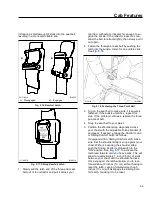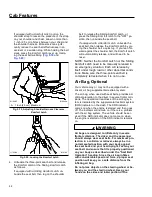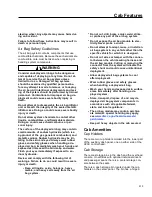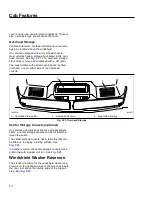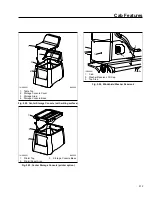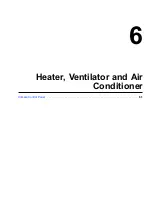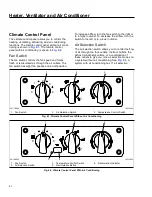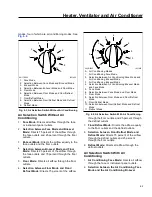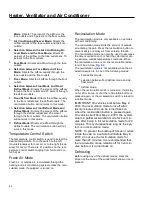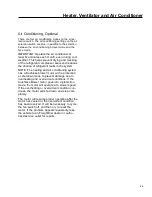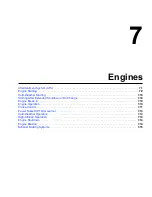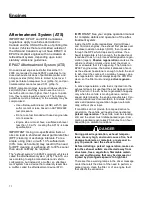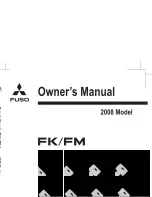
in this chapter for instructions on preventing au-
tomatic regen if necessary.
The exhaust temperature can remain high even
after the vehicle has stopped. When stopping the
vehicle shortly after an automatic regen, ensure
the exhaust outlets are directed away from struc-
tures, trees, vegetation, flammable materials, and
anything else that may be damaged or injured by
exposure to high heat.
Operating at reduced engine load will allow soot to
accumulate in the DPF. When this occurs, the DPF
lamp illuminates, indicating that a regen must be per-
formed, and the driver must either bring the vehicle
up to highway speed to increase the load, or park
the vehicle and initiate a parked regen. See
Parked
Regen
, later in this chapter for instructions.
After the exhaust stream passes through the ATD, it
flows through another canister housing the SCR de-
vice. A controlled quantity of diesel exhaust fluid
(DEF) is injected into the exhaust stream, where heat
converts it to ammonia (NH
3
) gas. This mixture flows
through the SCR device, where the ammonia gas
reacts with the NOx in the exhaust, to produce harm-
less nitrogen (N
2
) and water vapor (H
2
O), which then
exits out of the tailpipe.
ATS Warning Lamps
The malfunction indicator lamp (MIL) illuminates to
indicate a fault that affects the emissions. See
Fig. 7.3
.
Warning lamps in the driver’s message center alert
the driver of situations with the aftertreatment sys-
tem. A decal attached to the driver’s sun visor ex-
plains the aftertreatment system DPF, HEST, and
DEF warning lamps. See
Fig. 7.6
.
•
An illuminated DPF lamp indicates a regen is
needed.
•
A slow, 10-second flashing of the HEST lamp
alerts the driver that a parked regen is in
progress, but the exhaust temperatures are still
relatively cool. It also indicates that the high-
idle speed is being controlled by the engine
software, not the driver.
•
A steadily illuminated HEST lamp alerts the
operator of high exhaust temperatures when
vehicle speed is below 5 mph (8 km/h) while it
is performing an automatic regen, and during a
parked regen.
•
An illuminated DEF warning lamp in the gauge,
indicates that the DEF tank should be refilled
at the next opportunity.
Parked Regen
DANGER
During parked regeneration, exhaust tempera-
tures are very high, and could cause a fire, heat
damage to objects or materials, or personal in-
jury to persons near the exhaust outlet.
Before initiating a parked regeneration, make cer-
tain the exhaust outlets are directed away from
structures, trees, vegetation, flammable materi-
als, and anything else that may be damaged or
injured by prolonged exposure to high heat.
See
Fig. 7.7
for an explanation the ATS warnings,
and actions required to avoid further engine protec-
tion sequences.
The regen switch, located on the dash, is used to
initiate a parked regen of the aftertreatment device. It
is a momentary switch, that you press and hold for 4
seconds to activate. See
Fig. 7.4
.
NOTE: The regen switch can initiate a parked
regen only when the DPF lamp is illuminated
(because the engine software is signaling for a
parked regen.)
The regen-inhibit switch provides additional control
over the aftertreatment regeneration process. A driver
may decide to use this feature if they are hauling
cargo that should not be exposed to possible high
exhaust temperatures from an automatic regen.
When activated, the inhibit switch will stop a regen-
eration cycle in progress, and prevent the start of a
regeneration cycle until the switch is no longer ac-
tive. See
Fig. 7.5
.
To initiate a parked regeneration, perform the follow-
ing steps.
1.
Park the vehicle away from all combustible and
flammable materials. Chock the tires. Start and
warm the engine until the coolant temperature is
at least 150°F (66°C).
2.
Set the parking brake. If the parking brake was
already set, you must release it, then set it
again.
Engines
7.4

